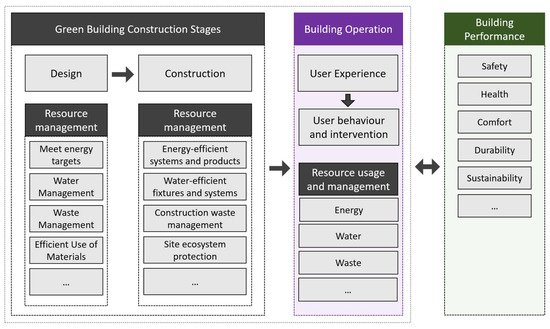
| Version | Summary | Created by | Modification | Content Size | Created at | Operation |
|---|---|---|---|---|---|---|
| 1 | Mehdi Amirkhani | + 3450 word(s) | 3450 | 2021-06-18 08:06:13 | | | |
| 2 | Nora Tang | -6 word(s) | 3444 | 2021-06-21 10:02:20 | | | | |
| 3 | Vicky Zhou | -2906 word(s) | 538 | 2022-04-13 12:12:47 | | |
Video Upload Options
Green buildings refer to buildings that decrease adverse environmental effects and maintain natural resources. They can diminish energy consumption, greenhouse gas emissions, the usage of non-renewable materials, water consumption, and waste generation while improving occupants’ health and well-being. As such, several rating tools and benchmarks have been developed worldwide to assess green building performance (GBP), including the Building Research Establishment Environmental Assessment Method (BREEAM) in the United Kingdom, German Sustainable Building Council (DGNB), Leadership in Energy and Environmental Design (LEED) in the United States and Canada, Comprehensive Assessment System for Built Environment Efficiency (CASBEE) in Japan, Green Star in Australia, Green Mark in Singapore, and Green Building Index in Malaysia. Energy management (EM) during building operation could also improve GBP. One of the best approaches to evaluating the impact of EM on GBP is by using structural equation modelling (SEM). SEM is a commanding statistical method to model testing. One of the most used SEM variance-based approaches is partial least squares (PLS), which can be implemented in the SmartPLS application. PLS-SEM uses path coefficients to determine the strength and significance of the hypothesised relationships between the latent constructs.

Figure 1. Building recourse management at different stages.
Research suggests that implementing energy-efficiency strategies at the design stage can significantly influence building performance and reduce energy usage [3][4][5]. As such, there has been an increasing amount of literature on zero energy building construction and renewable energy sources [6]. These studies have investigated, proposed, and improved different parameters, indices, and approaches to improving building performance [7][8][9]. They primarily focus on enhancing building systems and integrating renewable energy at the design phase using various building performance simulation (BPS) tools. The most commonly used approach to applying BPS tools during the design phase is based on evaluating the simulation outcomes, and if not satisfactory, the design is altered until the desired results are achieved. One of the limitations of this approach is that it uses direct modelling and simulation workflow in which the impacts of modifying the values of parameters on energy performance are examined one at a time, without considering the combined impacts of parameters [10]. An accurate and simplified prediction method of users’ comfort in buildings is another major challenge of using BPS tools. Several parameters, such as human behaviour in buildings, their interventions in design conditions, resource usage, and management, can significantly negatively impact the predicted energy saving. In practice, it is a challenge for building designers to assess the possibility of achieving predicted energy usage at the design stage. There is also little published data on user interventions and RM during the operation phase of the buildings and their impact on energy usage. Figure 1 gives a brief description of RM.
References
- Hamdaoui, S.; Mahdaoui, M.; Allouhi, A.; El Alaiji, R.; Kousksou, T.; El Bouardi, A. Energy demand and environmental impact of various construction scenarios of an office building in Morocco. J. Clean. Prod. 2018, 188, 113–124.
- Jin, X.; Wu, J.; Mu, Y.; Wang, M.; Xu, X.; Jia, H. Hierarchical microgrid energy management in an office building. Appl. Energy 2017, 208, 480–494.
- Abediniangerabi, B.; Makhmalbaf, A.; Shahandashti, M. Deep learning for estimating energy savings of early-stage facade design decisions. Energy AI 2021, 5, 100077.
- Fan, Y.; Ito, K. Integrated building energy computational fluid dynamics simulation for estimating the energy-saving effect of energy recovery ventilator with CO2 demand-controlled ventilation system in office space. Indoor Built Environ. 2014, 23, 785–803.
- Shen, J.; Zhang, X.; Yang, T.; Tang, L.; Wu, Y.; Pan, S.; Wu, J.; Xu, P. The early design stage of a novel Solar Thermal Façade (STF) for building integration: Energy performance simulation and socio-economic analysis. Energy Procedia 2016, 96, 55–66.
- Rezaee, R.; Vakilinezhad, R.; Haymaker, J. Parametric framework for a feasibility study of zero-energy residential buildings for the design stage. J. Build. Eng. 2021, 35.
- Hu, M. Net Zero Energy Building: Predicted and Unintended Consequences; Routledge: Abingdon, UK, 2019.
- Lechner, N.; Wallace, C. Heating, Cooling, Lighting: Sustainable Design Methods for Architects, 4th ed.; Wiley: Hoboken, NJ, USA, 2015.
- Garg, V.; Mathur, J.; Bhatia, A. Building Energy Simulation: A Workbook Using DesignBuilder; CRC Press: Boca Raton, FL, USA, 2017.
- Kerdan, I.G.; Raslan, R.; Ruyssevelt, P.; Gálvez, D.M. An exergoeconomic-based parametric study to examine the effects of active and passive energy retrofit strategies for buildings. Energy Build. 2016, 133, 155–171.




